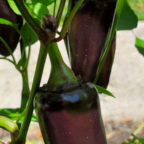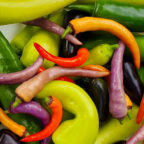Organic Fertilizer and Growing Peppers
My preference is for organic fertilizer, especially when it comes to growing anything (like peppers) that I plan to eat.  And while I realize that not everyone is comfortable with using organic, I really do think it’s best.
Organic Fertilizer and Worms
Now my absolute favorite is worm castings, but in the past it’s been difficult to find in small enough quantities for a reasonable price. However, here are some earthworm castings in the smaller quantities — I usually get it in the 15 lb size.
I like earthworm castings because they have always seemed to me (in my growing) that the plants just like the nutrients the castings give to the soil. No burning, totally organic, but nevertheless, quite concentrated; a fairly little amount can fertilize a lot of plants. Instead of mixing it in with my potting mix or garden soil, I just put a handful in each hole before I plant my seedlings or starters.
But I’ve found something else pretty recently that I like; it’s called Terracycle organic fertilizer.
You may be asking…TerraCycle? What the heck it that? Well, it’s liquified worm castings…or as described on the container, “worm poop”. Inelegant, but accurate. ;)  So, think worm castings, dissolved in water so that it’s neat and super-easy to use on your plants.
And one other thing about TerraCycle is that it’s actually packaged in recycled materials, which is better for the environment.  So altogether it’s great for the organically-inclined gardener.
Other Organic Fertilizers
Another organic fertilizer that I like is called fish emulsion. Yep, it’s pretty much what it sounds like; liquified fish. Great for the plants, although a little on the aromatic side. Still, it feeds the soil as well as the plants, so it still gets a two thumbs up in my book. You’ll find it in just about any garden center. Sometimes it’s in a power form other times it’s a concentrated liquid. In either case, you need to add water to it before using.
Can’t forget about plain old compost! You can buy it pretty much at any garden center, but try to find one labeled organic. I know, in theory it should be organic by definition, but labeled organic means that the manufacturer had to pass some pretty stringent guidelines to be able to call it organic.
If you have the space and the time to make your own compost, it’s absolutely fantastic!!!! I highly recommend it. Basically you need things like household garbage (not including anything with protein, fat or plastic) and a means to compost it, like a compost bin. Personally, I am eyeing the Yimby Tumbler Composter
— it’s on my wish list.
It generally takes a few months to create good compost, but there are some that can create compost in a month or so. But whether it’s one month or six months, the most important thing is that the result is well-composted. Here’s a hint; it’s ready when there is no smell to the compost; if it still has an odor, it’s not “done”.
Let’s not forget about cow or horse manure. Cow manure is easily found in a garden center. Horse manure is generally only available if you have horses or know someone else who does.  Poultry manure is relatively easy to locate as well.
These are the major organic fertilizers that are whole-plant. There are others that can be used as supplements, such as blood meal and bone meal. There are also soil amendments like vermiculite, perlite, coconut coir and sphagnum moss that can help you to lighten dense soils. You can also check out my post on soil amendments for more info.
Pepper Plant Planting Instructions
If you’ve purchased seedlings, or if you’ve grown your own, here are the steps for transplanting the peppers. You’ll need:
- A shovel or trowel (for planting in the ground).
- A suitably large container (for growing in a pot).
- Soil and soil amendments (compost, aged manure, etc.).
- For larger pepper plants, a “cage” or a post (to help keep the peppers off the ground).
- Mulch.
- Your pepper plants.
For container growing, the general guide is that you need a container that will hold 3 or more gallons of soil and amendments. Very large pepper plants require at least a 5 gallon container, and 7 gallons is even better. Fill the container with the soil and amendments, about 1/2 way full.
If you are planting in your garden, dig a hole at least 18″ across and a foot deep (two feet deep is better). Place soil and amendments in the hole, filling it up about 1/2 way.
Pepper Planting Technique
Spread your fingers and place them over the top of the seedling container. Turn the container upside-down and gently tap the container until the pepper plant comes out. Place the plant in its final container or in the ground. Add soil and amendments until full, and gently firm the soil around the plant. Place the cage or the post in place (large varieties only).
Give your plant a good drink of water, and add more soil, if necessary. Finally, mulch the pepper; this helps prevent weeds from popping up, helps to regulate the moisture in the soil, and also helps to control soil-borne bacteria.
Fertilize your pepper plants after about a week; but only fertilize at 1/2 strength. Once the pepper blossoms appear, you can begin using fertilizer at 3/4 to full strength.
Wasn’t that easy?
Pepper Growth Requirements
Want to try your hand at growing peppers? It’s really not hard!
Whether your choice is bell, sweet or hot, you’ll find the guidelines for sun and warmth below.
Growing Peppers
Like most fruits and vegetables, peppers require at least 6 hours or direct sunlight a day. Peppers also require warm weather — frost will kill them. The ideal temperatures for most (not all!) peppers is the 80’s to 90’s during the day, with nights in the 60’s and 70’s. (Temperatures in degrees Farenheit.)
And you know something strange? When it comes to hot (chile) peppers, the hotter the climate the better! Well, maybe that’s not strange…
Peppers will grow and set fruit in warmer weather, as well as in cooler weather; they just won’t be quite as productive. Keep your local temperatures in mind when selecting pepper varieties. For example, a grower in the cool Pacific Northwest would be better off with early peppers (those that mature in 70 days or less), as well as peppers that are bred for cooler weather.
Live in a hot climate? As mentioned before, peppers, and especially chile peppers, like it hot! Just make sure that the peppers don’t get too much direct sunlight in the afternoons, or they might just shrivel up on you. Morning sun and afternoon light shade in the South is just the ticket.
So, keep your local climate in mind when selecting pepper varieties. Oh, and an adequate water supply is essential for peppers to produce fruits; an average of an inch of water per week is considered optimal, but if you live in a dry climate, you might want to provide a bit more.

